When it comes to improving your motorcycle's engine performance, there are practical steps you can take that make a noticeable difference. You might start with regular maintenance, but that's just the beginning. Upgrading components like the air intake and exhaust systems can greatly enhance airflow, while fine-tuning the fuel delivery guarantees peak combustion. There are also performance parts that can elevate your ride even further. Curious about how to implement these strategies effectively? The following tips can guide you through each essential aspect, making sure your bike runs at its best.
Key Takeaways
- Perform regular maintenance, including oil changes and air filter cleaning, to ensure optimal engine operation and longevity.
- Upgrade the air intake and exhaust systems to enhance airflow and reduce back pressure for improved performance.
- Invest in high-quality performance parts, such as fuel injectors and ECU remapping, to tailor engine management for peak efficiency.
- Monitor engine temperature and coolant levels to prevent overheating and protect against severe damage.
Understand Common Ducati Issues
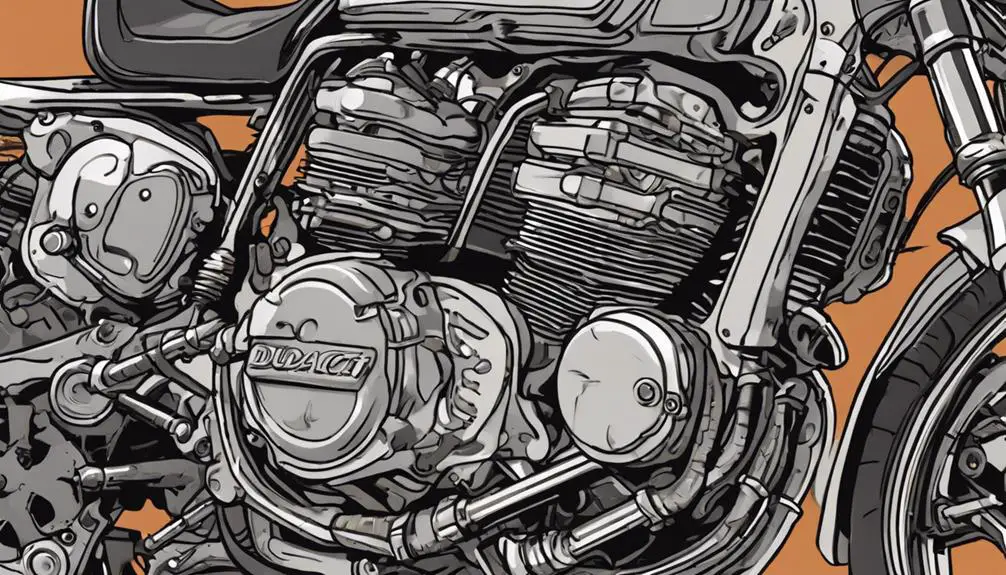
Many Ducati owners encounter specific issues that can affect their motorcycle's performance and reliability. You might notice that your bike struggles to start or runs rough. These problems often stem from electrical issues, especially with the battery or wiring. If your lights flicker or you hear unusual sounds, don't ignore them; they could indicate deeper problems that need addressing.
Another common issue is fuel system related. You might find that your bike hesitates during acceleration or feels sluggish. This could be due to clogged fuel filters or injectors, which restrict fuel flow and rob you of that exhilarating ride you crave. Regularly checking and cleaning these components can keep your Ducati running at peak performance.
Lastly, pay attention to the cooling system. Overheating can lead to severe engine damage, so verify your coolant levels are adequate and your radiator isn't blocked.
Understanding these issues empowers you to address them proactively, liberating you from the frustration of unexpected breakdowns. By staying vigilant and knowledgeable about your Ducati, you can enjoy the freedom of the open road without the worry of common pitfalls.
Optimize Air Intake Systems
To boost your motorcycle's performance, optimizing the air intake system is key.
You can start by upgrading your air filters, installing a performance throttle body, and enhancing the intake manifold design.
These changes can considerably improve airflow, giving your engine the power it needs.
Upgrade Air Filters
Upgrading your motorcycle's air filter can greatly enhance engine performance by optimizing the air intake system for better airflow and combustion.
When you switch to a high-performance air filter, you're allowing your engine to breathe freely. This means more air gets into the combustion chamber, leading to a more efficient burn, increased horsepower, and torque.
You don't have to settle for factory filters that can restrict airflow. Look for options like foam or cotton filters, which often provide superior filtration and improved flow. They're designed to trap dirt and debris while maximizing air intake, guaranteeing that your engine runs cleaner and cooler.
Installing a new air filter is usually a straightforward task that can be done with basic tools. Just make sure you follow the manufacturer's guidelines for your specific model.
Install Performance Throttle Body
Installing a performance throttle body is a great next step after upgrading your air filter, as it further optimizes your motorcycle's air intake system for improved power and responsiveness.
By increasing the diameter of your throttle body, you allow more air to flow into the engine, which translates to better combustion and, ultimately, more horsepower. This upgrade releases your bike's potential, making every ride feel like a thrilling escape.
When choosing a throttle body, consider the specific needs of your bike and your riding style. A larger throttle body can enhance performance, but make sure it aligns with your engine's capabilities and any other modifications you've made. The goal is to create a seamless flow of air that feeds your engine, allowing it to breathe freely and deliver that exhilarating power you crave.
Installation can be straightforward, but take the time to follow the manufacturer's instructions carefully. Once it's in place, you'll notice a remarkable difference in throttle response and acceleration.
This upgrade isn't just mechanical; it's about the freedom of the open road and the roar of your engine as it pulls you forward, ready to conquer new horizons.
Enhance Intake Manifold Design
Enhancing your intake manifold design can considerably boost your motorcycle's performance by optimizing airflow into the engine. When you focus on refining this essential component, you're allowing more air to flow efficiently, which translates to better combustion and increased horsepower.
Start by evaluating your current manifold's shape and material. Switching to a lighter, high-performance material can reduce weight and enhance airflow. A well-designed manifold should have smooth shifts and a larger volume to accommodate more air, which provides that exhilarating throttle response you crave.
Consider customizing the length of the runners, too. Shorter runners can improve high-end power, while longer ones enhance low-end torque. Experimenting with different configurations lets you tailor the performance to your riding style, whether you're tearing down highways or conquering tight corners.
Don't forget to pair your enhanced manifold with an optimized air filter system. A free-flowing air filter will complement your manifold's design, ensuring your engine breathes effortlessly.
Upgrade Fuel Delivery
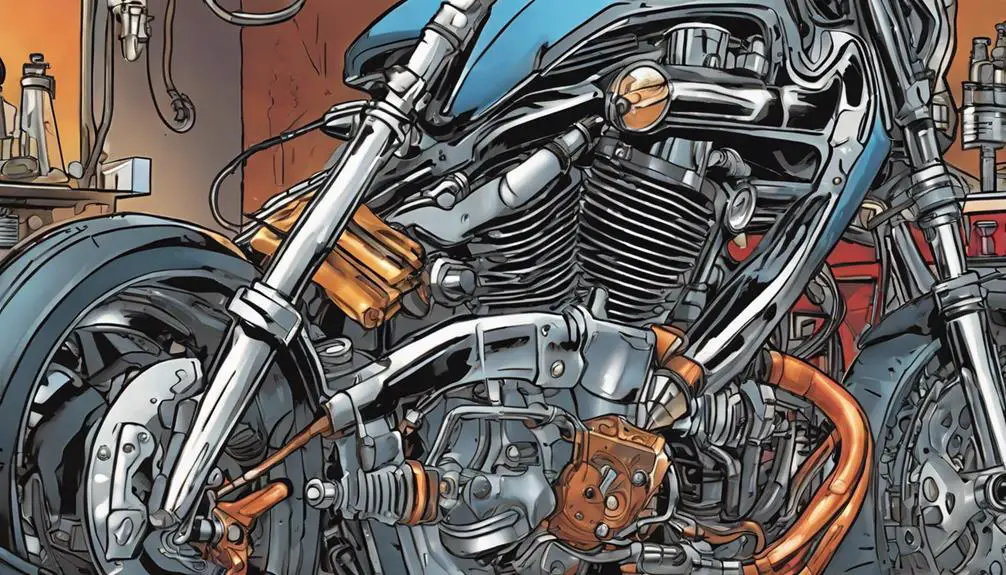
Improving your motorcycle's fuel delivery system can greatly boost engine performance and responsiveness. One of the first steps you can take is upgrading your fuel injectors. High-flow injectors allow for more precise fuel delivery, ensuring your engine gets the right amount of fuel when it needs it. This can enhance throttle response and overall power.
Next, consider installing a high-performance fuel pump. A pump that can handle increased fuel flow will support your engine's demands, especially if you've made other modifications. Don't forget about the fuel lines; replacing them with larger diameter lines can minimize restrictions and help maintain ideal fuel pressure.
Also, tuning your motorcycle's ECU is essential. A proper tune will enhance the air-fuel mixture, allowing your engine to run more efficiently. You might even look into a fuel management system if you're aiming for a more customized approach.
Enhance Exhaust Flow
To boost your motorcycle's performance, enhancing exhaust flow is essential.
You can start by upgrading your exhaust system and optimizing the header design.
These changes will help your engine breathe better and improve overall efficiency.
Upgrade Exhaust System
Upgrading your motorcycle's exhaust system considerably boosts exhaust flow, allowing your engine to operate more efficiently and produce better performance. A free-flowing exhaust reduces back pressure, letting your engine breathe easier and deliver the power you crave. You'll notice quicker throttle response, enhanced acceleration, and a more exhilarating ride.
When choosing an exhaust system, consider options like full systems or slip-ons tailored for your bike. A high-performance exhaust not only improves flow but also enhances the bike's sound, giving you that aggressive roar that commands attention on the road.
Don't forget to check the material; stainless steel or titanium systems are lightweight and resistant to corrosion, prolonging your investment. Remember, it's not just about power; it's about feeling free and connected to the ride.
Before making changes, verify that any upgrades comply with local regulations to keep your adventure on the right side of the law. With the right exhaust upgrade, you'll release your motorcycle's full potential, transforming your ride into a true expression of freedom and individuality. Embrace the upgrade, and let your engine sing!
Optimize Header Design
Optimizing your motorcycle's header design greatly enhances exhaust flow, allowing your engine to perform at its best. When you upgrade your headers, you're not just improving aesthetics; you're boosting performance and releasing the true power of your ride. A well-designed header reduces back pressure, enabling exhaust gases to exit more efficiently. This means your engine can breathe freely, increasing power and torque.
Consider the material of your headers, too. Stainless steel or titanium options can withstand high temperatures and resist corrosion, guaranteeing longevity. Additionally, look for headers with a larger diameter; they can greatly improve exhaust velocity, further enhancing performance.
You can also think about the length of the headers. Shorter headers can improve high-end power, while longer ones can enhance low-end torque. It's all about finding the right balance for your riding style.
Lastly, don't forget about proper installation. Even the best headers won't perform well if they're not fitted correctly. So, take the time to verify everything's aligned and sealed properly. By optimizing your header design, you'll feel the release of a powerful, responsive machine in every twist and turn.
Regular Maintenance Practices
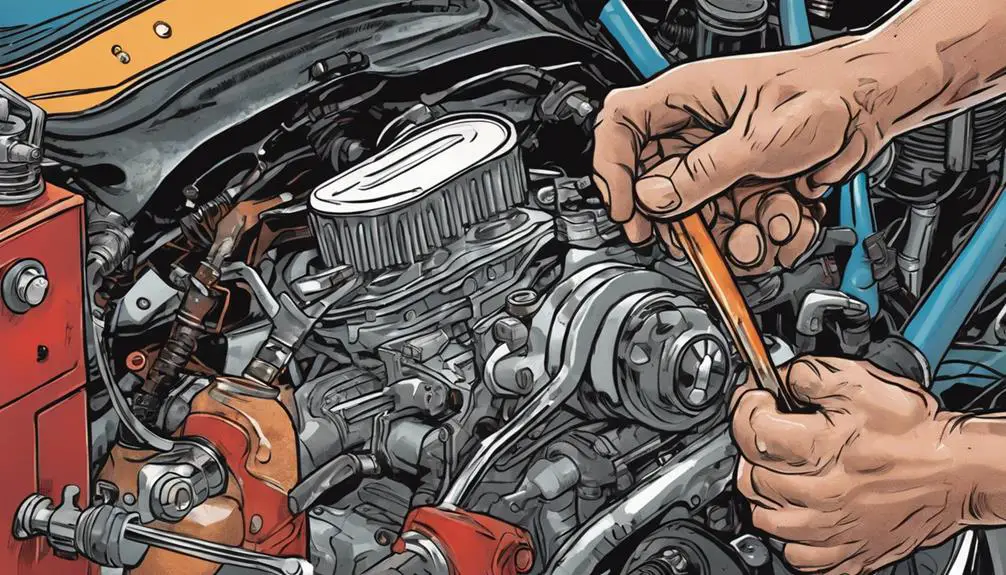
Regular maintenance practices keep your motorcycle running smoothly and can greatly enhance its performance over time. By taking the time to care for your bike, you're not just preserving its functionality; you're also embracing the freedom it brings.
Start with regular oil changes. Fresh oil guarantees your engine runs efficiently and helps prevent wear.
Next, check your air filter. A clean filter allows for proper airflow, boosting performance and fuel efficiency.
Don't forget to inspect your tires regularly. Proper tire pressure and tread depth not only enhance grip and handling but also keep you safe on the road.
Brake maintenance is essential, too. Verify your brake pads are in good condition and replace them as needed. This not only improves performance but also gives you confidence on every ride.
Check Engine Timing
Checking your engine timing is vital for maximizing your motorcycle's performance and ensuring a smooth ride. When your timing's off, you'll feel it in the throttle response and overall power delivery. It can lead to rough idling, poor acceleration, and even engine damage if left unchecked.
To check your engine timing, start by locating the timing marks on your engine and the flywheel. Use a timing light to illuminate these marks while the engine runs. It's important to have your motorcycle warmed up to get an accurate reading. If the marks don't align correctly, you may need to adjust the timing.
Don't forget to consult your motorcycle's manual for specific timing specifications and adjustment procedures. Remember, the freedom of the open road relies heavily on how well your engine runs.
If you're feeling adventurous, you might consider upgrading your ignition system for more precise timing adjustments. Tuning your engine timing isn't just about performance; it's about connecting with your machine and revealing its true potential.
Utilize Quality Oils
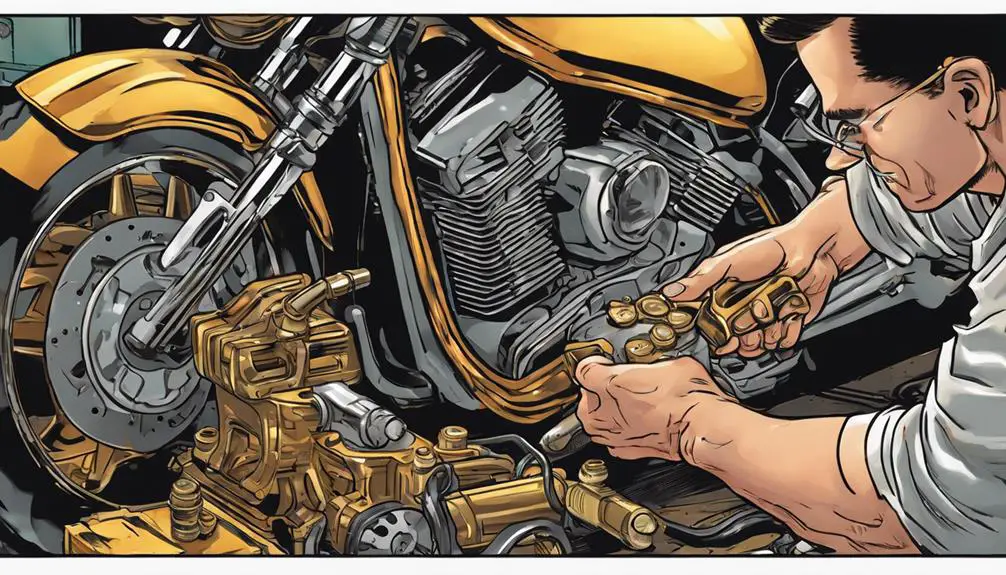
When it comes to maintaining your motorcycle's engine, using quality oils is essential.
You'll want to choose synthetic oils, stick to regular oil changes, and check viscosity ratings to keep your bike running smoothly.
These steps can greatly enhance your engine's performance and longevity.
Choose Synthetic Oils
Choosing synthetic oils for your motorcycle can greatly enhance engine performance and longevity. These oils are engineered to provide superior lubrication, reducing friction and wear on your engine's components. Unlike conventional oils, synthetic options stand up to extreme temperatures, ensuring your engine runs smoothly whether you're tearing down the highway or maneuvering through city streets.
When you make the switch to synthetic, you're not just choosing a product; you're embracing a lifestyle of freedom and adventure. Synthetic oils maintain their viscosity better, meaning they won't break down as quickly under stress. This leads to cleaner engine operation and improved fuel efficiency, allowing you to ride longer without constantly worrying about performance issues.
Additionally, many synthetic oils contain advanced additives that help keep your engine cleaner by preventing sludge and deposits. This means less time spent on maintenance and more time enjoying the open road.
Regular Oil Changes
Regular oil changes using quality oils are essential for maintaining your motorcycle's engine health and performance over time. When you invest in high-quality oil, you're fueling your ride's freedom and releasing its true potential. Quality oils provide better lubrication, reduce friction, and help prevent engine wear, ensuring your bike performs at its best.
You might think oil changes are just another maintenance chore, but they're crucial to keeping your engine running smoothly. By changing the oil regularly, you're flushing out dirt and debris that can accumulate, robbing your bike of power and efficiency. Embrace this routine as a ritual of liberation; each change signifies a commitment to your ride's longevity.
Don't settle for cheap or generic oils. They can lead to sludge buildup and premature engine failure, chaining you to costly repairs. Instead, choose oils that meet the manufacturer's specifications and support the unique requirements of your motorcycle.
Check Viscosity Ratings
Checking viscosity ratings is essential for ensuring your motorcycle's engine runs efficiently and stays protected under various temperature conditions. Viscosity refers to the oil's thickness and its ability to flow, which directly affects engine performance. When you choose the right viscosity, you're giving your engine the freedom to operate smoothly, whether you're cruising through city streets or tearing up open highways.
Always consult your owner's manual for the manufacturer's recommendations. You'll often find a specific viscosity grade that suits your bike perfectly. Using oil that's too thick can lead to sluggish performance, while oil that's too thin may not provide adequate protection. Remember, quality matters—opt for reputable brands that meet or exceed industry standards.
Don't forget to take into account the climate you ride in. If you frequently ride in extreme temperatures, you might need to adjust the viscosity accordingly. By being mindful of viscosity ratings, you're not just maintaining your engine; you're enhancing your riding experience, allowing you to feel the liberation of the open road without worrying about potential mechanical issues.
Embrace the journey, and keep your motorcycle performing at its best!
Invest in Performance Parts
Investing in high-quality performance parts can greatly enhance your motorcycle's speed and handling. When you upgrade components like the exhaust system, air intake, or fuel injectors, you reveal the full potential of your ride. These parts not only increase horsepower but also improve throttle response, giving you that exhilarating feeling of freedom as you blaze down the road.
You might consider a performance ECU remap, which tailors your bike's engine management system for peak performance. A lighter, more efficient exhaust can reduce weight and enhance airflow, making every twist of the throttle more responsive.
Don't forget about suspension upgrades, either; they can drastically improve your bike's stability and cornering capabilities, allowing you to tackle any twisty road with confidence.
Monitor Engine Temperature
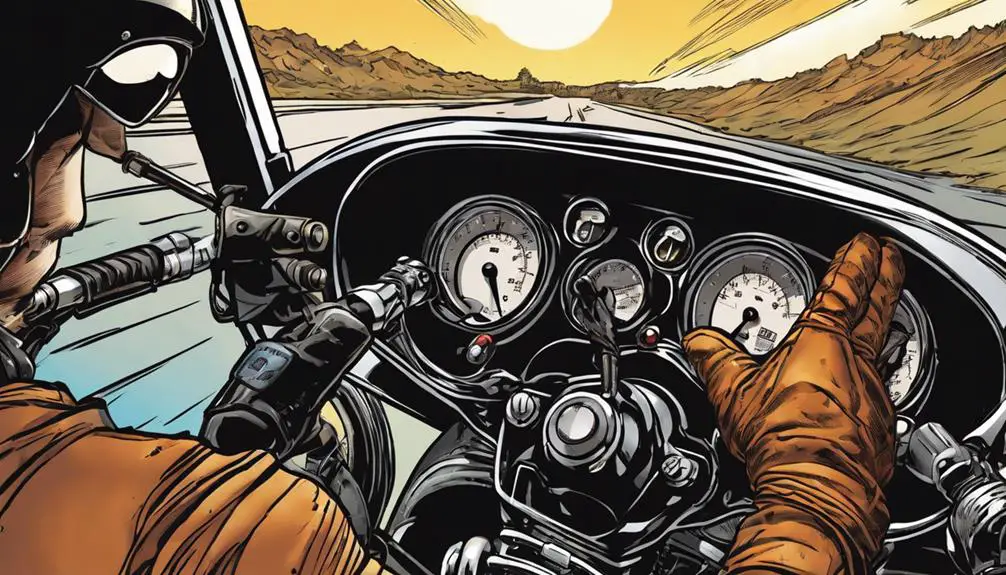
Upgrading performance parts can put more strain on your engine, making it vital to monitor engine temperature to guarantee peak performance and prevent overheating. Keeping an eye on those heat levels makes sure your ride stays smooth and powerful, allowing you to release your true potential on the road.
Here are four tips to effectively monitor your engine temperature:
- Install a Quality Gauge: Invest in an accurate temperature gauge that provides real-time readings. You want to know the heat levels at all times.
- Check Fluid Levels: Verify coolant and oil levels are adequate. Low levels can lead to overheating, so make this a regular habit.
- Pay Attention to Warning Lights: Your bike's dashboard offers important warnings. Don't ignore them! If the temperature light comes on, pull over and investigate.
- Take Breaks During Long Rides: Heat can build up during extended rides. Give your engine a breather every now and then to cool down and maintain peak performance.
Tune for Specific Needs
How can you guarantee your motorcycle runs at its best? Tuning for specific needs is essential to optimizing performance and tailoring your ride to your unique style and conditions. Whether you're carving through mountain passes or cruising city streets, the right adjustments can release the full potential of your bike.
Start by understanding your riding habits. Do you crave speed on open highways, or do you prefer nimble handling for urban adventures? Fine-tune your carburetor or fuel injection system to match your throttle response, ensuring smooth acceleration and power delivery. Adjust the ignition timing to strike the perfect balance between performance and efficiency.
Don't forget about exhaust modifications! A high-performance exhaust system can enhance airflow, giving your engine the freedom to breathe. Pair this with a suitable air filter, and you'll notice a significant boost in horsepower.
Lastly, consider suspension tuning. Adjusting your suspension settings for your weight and riding style can make a world of difference in handling. By tuning for your specific needs, you'll not only improve performance but also deepen your connection to the open road.
Embrace the ride, and let your motorcycle truly reflect your spirit of adventure!
Frequently Asked Questions
How Does Riding Style Affect Motorcycle Engine Performance?
Your riding style directly influences your motorcycle's engine performance.
When you accelerate smoothly and maintain steady speeds, you maximize fuel efficiency and reduce strain on the engine.
Abrupt starts and aggressive maneuvers can lead to overheating and increased wear.
By adopting a more controlled approach, you not only extend your bike's lifespan but also enhance your overall riding experience.
Embrace the freedom of the open road while respecting the machine beneath you!
What Role Does Weather Play in Engine Performance?
Weather's like a wild card in your motorcycle game. It can dramatically impact engine performance.
When it's cold, your engine might struggle to reach ideal temperature, affecting fuel efficiency and power. Conversely, high humidity can lead to a rich fuel mixture, causing sluggish acceleration.
If you ride in the rain, water can compromise electrical systems.
Can Adding Weight Improve Engine Efficiency?
Adding weight to your motorcycle won't improve engine efficiency; in fact, it often does the opposite.
More weight means your engine has to work harder, consuming more fuel and reducing performance.
Instead, focus on optimizing what's already there.
You'll find that lighter components or tuning can greatly enhance efficiency.
Embrace the freedom of a well-tuned machine that responds to your needs without the burden of unnecessary weight dragging you down.
How Often Should I Replace Spark Plugs for Optimal Performance?
You might think spark plugs are just little pieces of metal, but they're your engine's unsung heroes.
For peak performance, you should replace them every 5,000 to 10,000 miles, depending on your bike and riding style. Ignoring this can lead to poor fuel efficiency and rough idling, which isn't exactly liberating.
Do Aftermarket Warranties Cover Performance Upgrades?
Aftermarket warranties can be a bit tricky when it comes to performance upgrades. Most of the time, they don't cover modifications that alter your motorcycle's original specs, as they might consider these changes a risk.
You'll want to read the fine print and check with the warranty provider. If you're planning to upgrade, it's smart to weigh the benefits against potential costs in case something goes wrong.
Always stay informed!
Conclusion
By embracing these tips, you'll release your motorcycle's true potential, transforming it into a roaring beast on the open road.
Think of regular maintenance as the heartbeat, keeping everything in sync while performance upgrades are the wind beneath its wings.
As you fine-tune your ride, you'll not only enhance speed and handling, but also deepen your connection with the machine.
So, rev up those engines and let every ride become an exhilarating dance with freedom!